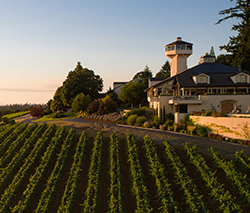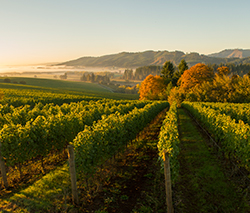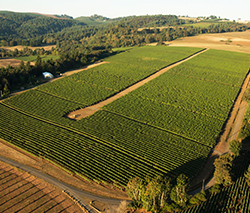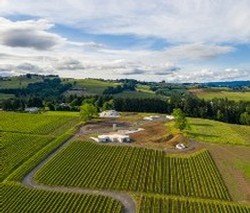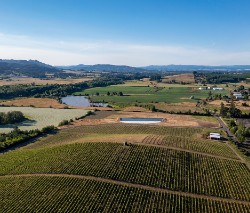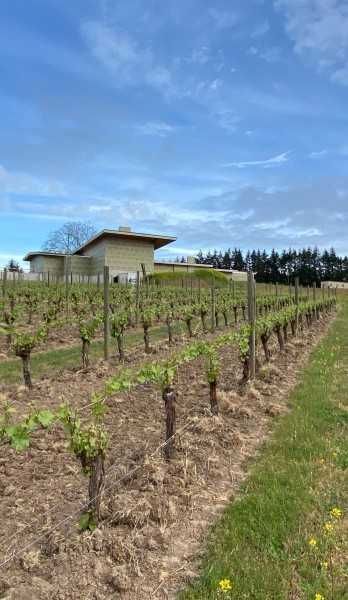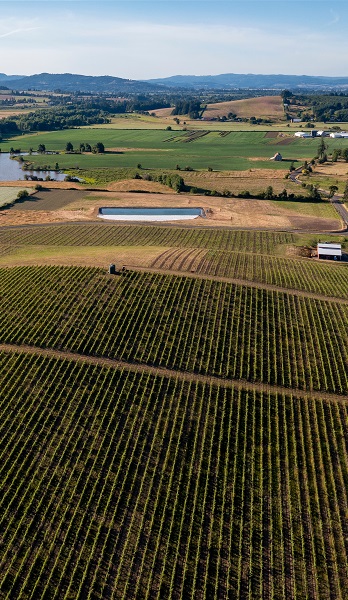Our Vineyards
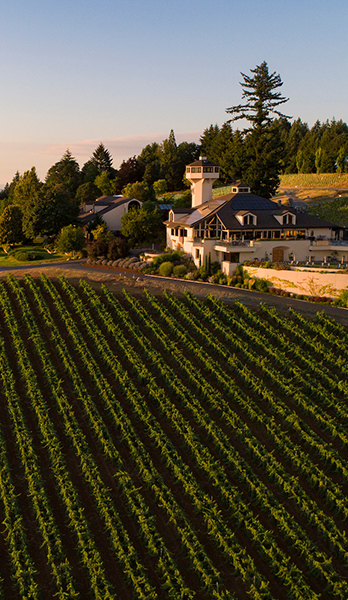
Willamette Valley Vineyards
Turner, Oregon
Willamette Valley AVA
The Estate Vineyard, located south of Salem, is planted on an old west-to-southwest facing volcanic flow. The pioneering Jory family, who first farmed the hill-site, found the ancient volcanic, iron-rich soil was ideal for dark, thin-skinned plums, which they dried into prunes. Wine grapes were first planted in 1983 by Founder Jim Bernau.
The vineyard site rises from 500-750 feet in elevation with seven to twelve degree slopes tilted toward the sun. As a result, the vines get excellent air drainage and are above the frost line. At this elevation and slope, the temperature is approximately 10 degrees cooler than the valley floor during the day.
The soil type is typically a clay loam, which is permeable to roots, retentive of moisture and runs five to seven feet deep. Because this soil is so old (estimated to be 10 to 14 million years old) rainwater has percolated through this now acidic soil, breaking down the basalt and allowing the roots to tap down. The Nekia and Jory soils are well-drained to a depth of two and a half to six feet.
The Estate Vineyard has a total of 67 acres of vines planted, with the first Dijon clones grafted in 1993. It is primarily planted with Pinot Noir Dijon clones 667, 777, Pommard and Wadenswil. Additionally, a portion is planted in Pinot Gris and Dijon Clone Chardonnay 76 and 96.
Wines made from this vineyard exude a sense of place and display complexity, elegance and balance.
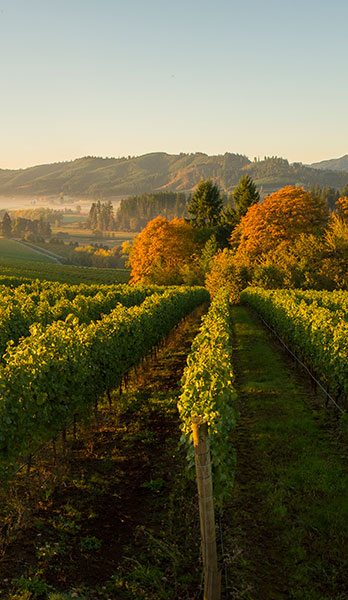
Tualatin Estate Vineyard
Forest Grove, Oregon
Tualatin Hills AVA
Tualatin Estate Vineyard, established in 1973, is one of the oldest and most respected vineyard sites in Oregon. Wine grapes from this 171-acre vineyard have produced world-renowned wines for more than 45 years. Tualatin is the only vineyard to have won the Best of Show for both the red and white categories at the London International Wine Competition in the same year. Tualatin’s Pinot Noir captured the Governor’s Trophy, Oregon’s most prestigious wine award, two years consecutively in 1994 and 1995. This is a feat unduplicated by any Oregon winery. Tualatin Estate Vineyard is proudly owned through a merger accomplished in 1997 with Willamette Valley Vineyards.
The name “Tualatin” originates from local indigenous people and means “gentle and easy flowing,” referring to the Tualatin River that meanders on its way to the confluence with the Willamette River. The site is located in the coastal rain shadows near Forest Grove, Oregon. It is planted with Pinot Noir, Chardonnay, Riesling, Gewürztraminer, Muscat and Pinot Blanc. Our most recent plantings reflect the site’s affinity to ripening Pinot Noir, with forty-five new acres planted to seven different French clones, all grafted onto phylloxera-resistant rootstock. The new plantings are spaced at twice the plant density of the original vineyard to improve vineyard ripening potential by limiting the crop on a per plant basis. This will yield wines that are more consistent from year to year as well as more complex structurally due to the clonal diversity.
The unique Laurelwood soil profile at Tualatin has also contributed to the complex nature of the wines. The top twenty-four inches is a distinct layer of well-drained silt loam deposited from a volcanic eruption of Mt. Hood nearly 10,000 years ago. This feature allows any excess topsoil moisture to drain away from the vine’s feeding roots. The top layer is also riddled with deposits of unique, iron concretions called “pisolites” and are caused by the weathering of the minerals. Some say "pisolites" add more rose petal aromas to the wines produced from this soil. Below the topsoil layer is deep jory clay, which has a high water holding capacity to sustain the vine during drought conditions.
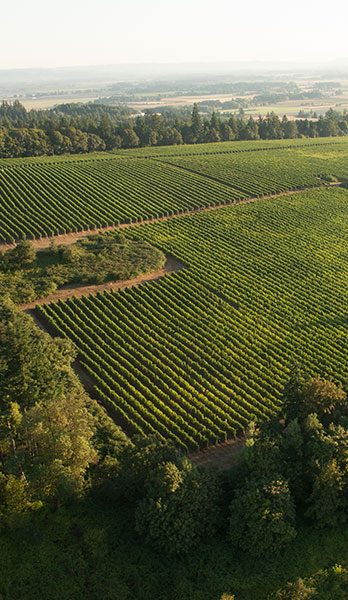
Elton Vineyard
Salem, Oregon
Eola-Amity Hills AVA
In 2007, Elton Vineyard was named one of Oregon’s top ten vineyards by Wine Press Northwest, and in 2006 Wine & Spirits listed it as one of the five key vineyards in the new Eola-Amity Hills American Viticultural Area. Owned by Dick and Betty O'Brien, the vineyard was planted on land inherited from Betty’s parents, Elton and Peggy Ingram – hence the name Elton Vineyard and the address on Ingram Lane. Upon the O’Brien’s retirement in 2007, the vineyard was contracted under a long-term lease to Willamette Valley Vineyards.
The first five acres of wine-grapes were planted in 1983 by the O’Briens. The vineyard now includes 67 acres planted on east-southeast slopes of the Eola Hills, just west of Hopewell, in Yamhill County, in the Eola-Amity Hills AVA. The elevation rises from 250-500 feet, and the vineyard soil is primarily Jory and Nekia.
The majority of the vineyard is planted in Pinot Noir; including Pommard, Wadensville, 115, 777 and 114 clones. The vineyard also includes Dijon Chardonnay, Pinot Gris and a small amount of Grüner Veltliner grapes. Wines made from Elton Vineyard grapes, by several winemakers, have been rated 90+ points by the Wine Advocate, Wine Spectator and others. The Willamette Valley Vineyards Elton Vineyard Pinot Noir was first released in 2007.
Bernau Estate Vineyard
Dayton, Oregon
Dundee Hills AVA
Named in honor of our Founder Jim Bernau, Bernau Estate Vineyard is located in the Dundee Hills and is home to our méthode traditionnelle sparkling wine facility, which opened in 2022. The vines at Bernau Estate Vineyard are farmed using biodynamic techniques. In 2023, the Estate received Demeter Certification.
Biodynamic farming uses sustainable, organic practices like composting and the use of special preparations to holistically promote the soil's long-term health. This type of farming involves using the principles of a living organism and is minimally dependent on outside materials to meet the needs of the land. To learn more about these practices, including cow horn burials, check out our Biodynamics blog post.
The original 15 acres of Pinot Noir were planted in 1994 and in 2019 we added an additional nine acres of Pinot Meunier, Chardonnay and Pinot Noir.
The vineyard has a very gentle south west facing slope and mostly Woodburn soils, which are dark brown in color, deep and well drained.
Loeza Vineyard
Gaston, Oregon
Tualatin Hills AVA
Named in honor of our Vineyard Manager Efren Loeza and his family for their contributions to our winery and the Oregon wine industry, this vineyard located near Gaston, Oregon, consists of 23 acres of Pinot Noir and 22 acres of Pinot Gris, with plans to plant an additional 3-5 acres of Pinot Noir in 2025.
Efren traveled from Michoacán, Mexico in 1978 as a teenager with his father to Cornelius, Oregon. Efren found his way to Bill Fuller’s Tualatin Estate Vineyard in 1979 and became enamored with growing wine grapes. He used this passion and the support of others to learn, improve and create a home for his family.
To give thanks to Efren and his family for more than 40 years of dedication, Founder and CEO Jim Bernau purchased a unique piece of land on a knoll formed by the power of the Missoula Lake Floods and named it Loeza Vineyard. We broke ground in 2016 and 2020 was the first harvest of fruit.
Loeza Vineyard has a gentle south facing and a steeper north facing slope with Helvetia and Cornelius silt loam soils. Loam soils are ideal for plant growth because they are a combination of sand silt and clay.
The rain catchment pond at Loeza Vineyard is a unique way to preserve precious groundwater and create a sustainable watering system for the wine grapes at Loeza Vineyard. Rain is abundant in Oregon's Willamette Valley and the rainwater catchment bib collects rainwater and funnels it into the reservoir. At full capacity, the reservoir will hold 2.3 million gallons of rainwater.
Sign Up For Our Newsletter
Be among the first to hear about new releases, local events and wine specials.
Plus, receive complimentary shipping on your first order of $200+
